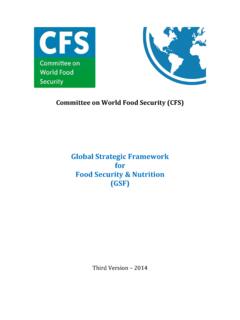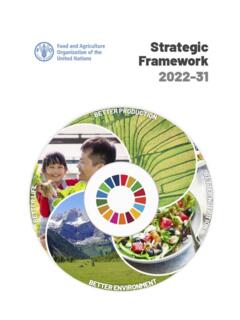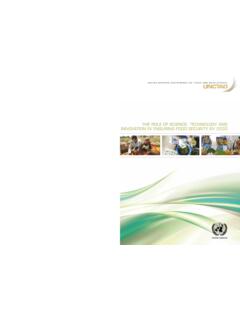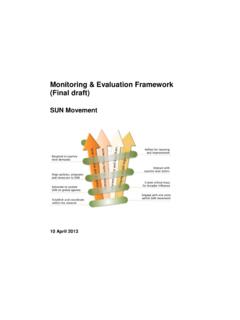Transcription of DFID’s Conceptual Framework on Agriculture
1 DFID's Conceptual Framework on Agriculture Akash November 2015. Month 2012 A DFID Strategic document Contents Contents 1. Foreword 1. Executive Summary 2. Background 4. 1. The context: key opportunities, challenges and risks 6. 2. DFID's long-term perspective on Agriculture 8. 3. DFID's future approach to promote agricultural transformation and support rural transition to benefit the poor 12. Annexes 28. Endnotes 31. Foreword Agriculture is an important sector for many developing countries, both to drive economic development but also to support poverty reduction and boost food and nutrition security . DFID has not updated its thinking about Agriculture since 2005, but the world has changed immensely. We have achieved significant successes in reducing poverty and hunger, and have boosted the incomes and livelihoods of many people, including in the poorest countries.
2 At the same time, new challenges and opportunities have presented themselves. For example, how will we ensure the food security of a rapidly growing global population in an era of climate change and increasing shocks and disasters? How to make Agriculture more productive and food systems more sustainable and resilient? How to better benefit girls and women who make up the majority of people working in Agriculture in developing countries, but who are not currently getting enough from their labours? How to adopt a new approach to Agriculture in a context where more and more people migrate to towns and cities, and where plot sizes and climatic conditions make it less and less likely that future generations will be able to feed themselves and their families with their own agricultural production?
3 We have looked at the evidence and come to the conclusion that what is needed is a more differentiated approach to the way in which we support Agriculture . There are farmers who are already sustainably linked into markets and who are able to access commercial loans for their farming businesses. There is also a missing middle , which in many developing countries is a very large group of farmers who may need just a bit more support to become sustainably linked to markets and increase their incomes, be it through rural infrastructure, extension work, small grants for them to afford high quality inputs, support to aggregate production, or to become otherwise linked into markets. There is also a group of farmers and their families who may require support to diversify strategically or may wish to move out of Agriculture altogether.
4 We have considered the evidence on all of these cases and have produced the present Conceptual Framework which will guide our forthcoming policy and programme choices. Our new strategic approach will take a more differentiated approach to what we do, with whom, and where we provide this tailored kind of support. This will help better unlock the potential of Agriculture to drive inclusive growth, reduce poverty and build sustainable food systems, while making a substantial contribution to achieving the Global Goals. Rt Hon Desmond Swayne TD MP. Minister of State for International Development 1. Executive Summary This paper sets out a Conceptual Framework to guide DFID's future approach to Agriculture and the agrifood sector. Its focus is on the role Agriculture and agroindustry can and need to play in supporting inclusive economic growth and poverty reduction, food and nutrition security , and environmentally sustainable food production.
5 Some of the key opportunities, challenges and risks faced by the agrifood sector (encompassing Agriculture and agroindustry) and considered in this policy Framework include: that poverty will remain a predominantly rural phenomenon for the foreseeable future; persistent, high levels of food insecurity and malnutrition despite increased global food production per capita; the projected rise in food demand over the coming decades in the context of climate change and resource scarcity and increasing pressure on global supply. DFID's long-term perspective on Agriculture is based on the assumption that sustained wealth creation and a self-financed exit from poverty depend, in the long-term, on economic transformation and the majority of the rural poor finding productive and better paid employment outside of primary agricultural production.
6 Despite the need for this transition, agricultural growth and downstream processing and productivity growth are likely to be important, if not essential, as a continued source, if not driver, of growth. Agriculture sector growth, where it can be achieved cost-effectively, is likely to have a bigger impact on poverty reduction than growth in other sectors as it offers the most direct route of raising returns to poor people's main assets, land and labour. A key challenge is to find the right balance between investments and interventions that create long-term pathways out of poverty, whether in the agrifood sector or in other manufacturing and services, and those that enable the rural poor to make better use of existing assets and livelihood strategies in Agriculture and the informal sector, until sufficient productive off-farm jobs can be created.
7 This calls for a twin strategy, on the one hand, promoting agricultural transformation ( stepping up' in Figure 1) focused on commercialisation and agroindustry development, to create jobs and raise incomes and, on the other, facilitating a long- term rural transition from subsistence Agriculture to off-farm job opportunities as these emerge (from hanging in' to stepping out'). Promoting agricultural transformation and rural transitions therefore requires a dynamic and context-specific approach to Agriculture , with Agriculture programmes and policy integrated into economic development strategies. It is also important to be clear how the intervention in the agrifood sector will contribute, directly or indirectly, to poverty reduction, food and nutrition security , and sustainable food systems.
8 Efforts to promote agricultural transformation and rural transitions also need take account of the degree of small-scale farm differentiation and the opportunities or constraints this creates for Agriculture as a pathway out of poverty. 2. Successful agricultural transformation depends on a strong enabling environment being in place. Broad-based agricultural transformations that leave no one behind require public interventions to address coordination and market failures in addition to investing in public goods, in particular rural roads and infrastructure, Agriculture research, and creating an enabling policy environment and investment climate. Agriculture and agribusiness are predominantly a private sector activity. Investment which results in a positive impact on poor people's incomes and a country's economic growth is dependent on the capacity and incentives of a broad range of actors.
9 Technology and innovation are equally important not least as a key driver of productivity growth and value addition. Promoting agricultural transformation will require a specific focus on market and value chain development that will help smallholder farmers to become sustainably profitable and respond effectively to market demand. Interventions to promote inclusive agricultural transformation need to consider (a) the scale of farms and agribusinesses development that will deliver both growth and poverty reduction; (b) the institutional arrangements that will enable the largest number of smallholder farmers and workers to participate in and benefit from commercialisation; (c) the value chains or related agribusiness investments that will benefit the largest number of poor people in the long-run, as producers, workers or consumers; and, (d) the main risks from prospective agribusiness investments that need to be prevented or mitigated.
10 Farm production is unlikely to provide a rapid pathway out of poverty for the majority of the rural poor, and most will continue to depend heavily on own-account farming for food security and as an importance source of cash income for the foreseeable future, until economic opportunity outside Agriculture increases. To facilitate this, governments need to adopt a dynamic approach to subsistence Agriculture , which builds the resilience of smallholders and raises returns to existing farm assets, but at the same time integrates such programmes with other interventions to promote growth, jobs and increased incomes in the rural non-farm economy. Facilitating greater mobility between sectors and rural and urban areas to optimise access to better opportunities for poor people will be essential.














